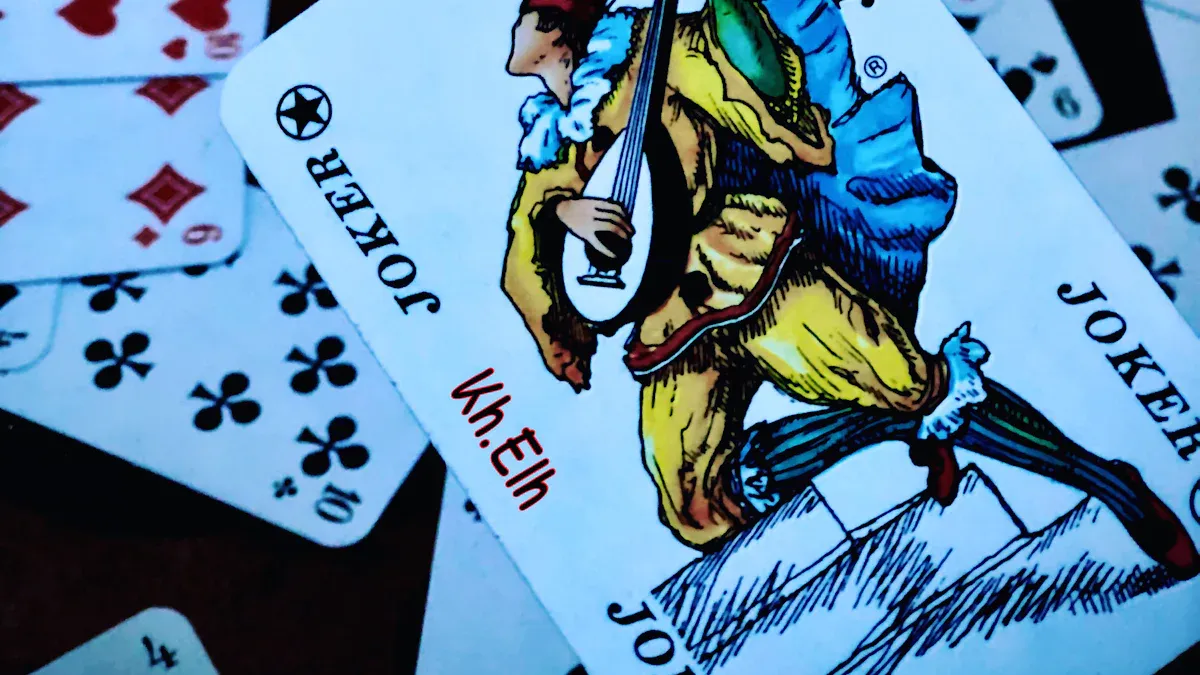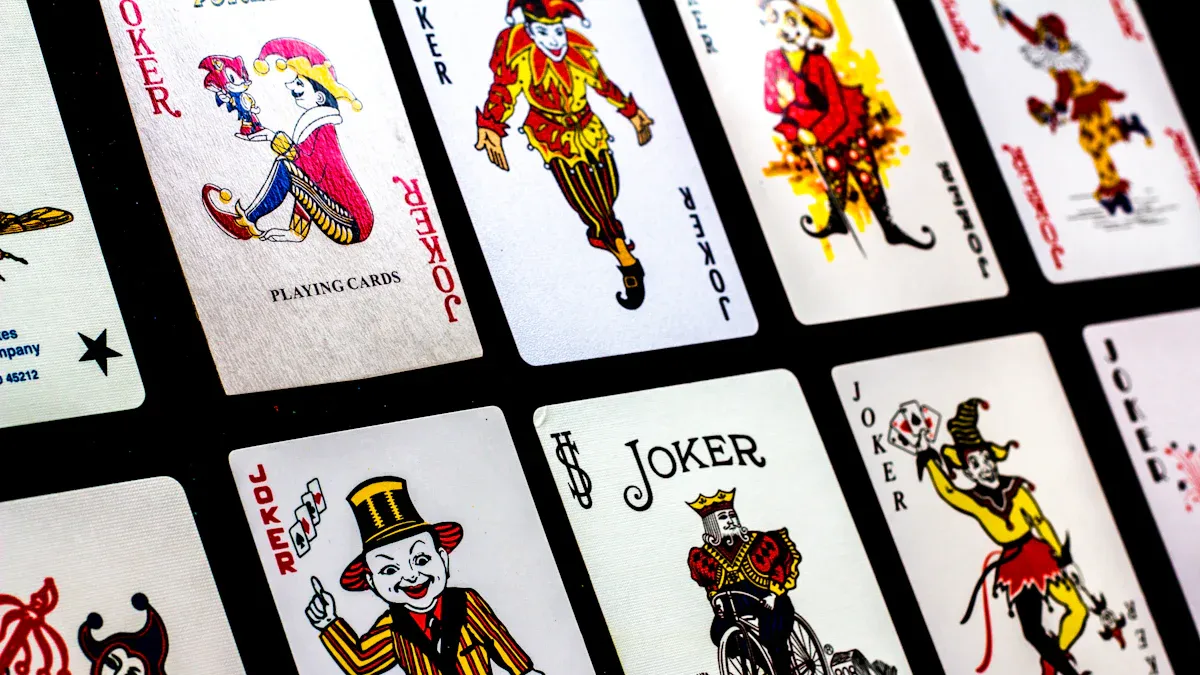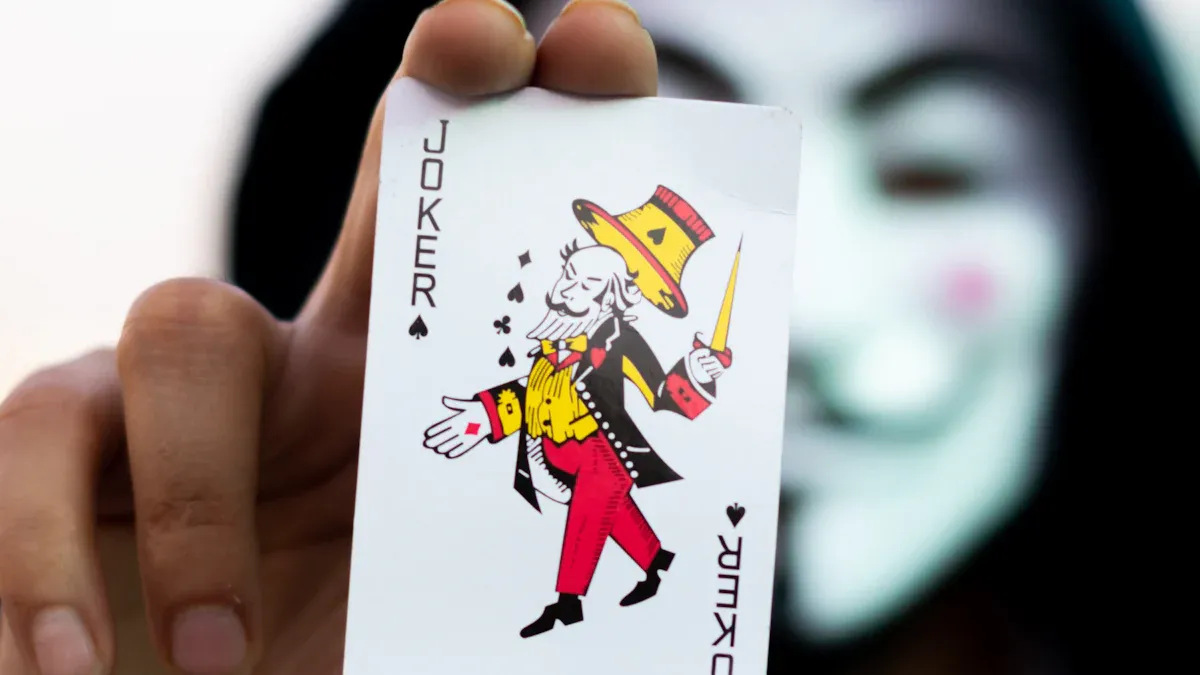
When you think of the joker card, chaos and unpredictability might come to mind. This card, with its roots in 19th-century playing cards, lacks a specific rank or suit, making it a wildcard. The joker card meaning is all about adaptability and freedom. It embodies the trickster archetype, challenging norms and questioning authority. This joker symbolism resonates across cultures, suggesting that breaking the rules can lead to positive change. You see this in popular culture, where the joker appears in movies, literature, and art, like the infamous character from the Batman series. The joker meaning in cards goes beyond games, symbolizing a non-conformist spirit that captivates us all.
Key Takeaways
The joker card stands for chaos and surprises in life.
It started in the 19th century as a special card in Euchre.
Now, it is a key part of many card games.
The joker can replace any card, making games more flexible.
It represents a trickster, breaking rules and sparking creativity.
In art and culture, the joker shows rebellion and being unique.
It inspires people to challenge rules and accept new ideas.
The Historical Origins of the Joker Card

The Joker Card’s Beginnings
Origins in 19th-century card games
The joker card has a fascinating backstory that ties directly to the evolution of card games in the 19th century. It first appeared in the United States during the 1850s, introduced as an extra trump card for the game of Euchre. This addition was necessary to enhance gameplay, creating a card that ranked higher than all others. By 1868, official rules for Euchre included this new card, marking its formal entry into the world of playing cards.
The earliest known references to the Joker card in card games primarily relate to its introduction in the game of Euchre during the 1850s, with the first documented use in rules from 1868. The term ‘Joker’ began appearing on cards around the late 1860s, with various designs including clowns and jesters.
Interestingly, the term “Joker” is believed to have been inspired by the German game “Juckerspiel,” which influenced Euchre’s card rankings. The NY16 deck, created around 1871, is thought to be the first to label this card as “The Joker,” following a poem published in 1870.
Connection to the game of Euchre
Euchre played a pivotal role in the history of joker cards. Before the joker existed, Euchre used a 32-card pack. The addition of the joker transformed the game, introducing a new level of strategy. Players quickly embraced this wildcard, which could trump any other card. This innovation not only enhanced Euchre but also set the stage for the joker’s inclusion in other card games.
The first Joker card came into existence during the late 1800s. When new rules in the game of Euchre appeared during the 1860s, they needed an extra trump card of the highest rank.
Evolution of the Joker Card
How the Joker became a standard card
The joker’s journey from a Euchre-specific card to a standard playing card is a testament to its versatility. Initially, it was exclusive to Euchre, but its unique role as a wildcard caught the attention of other card game enthusiasts. Over time, the joker became a staple in standard 52-card decks, adding an element of unpredictability to games. Its adaptability made it a favorite among players, and its inclusion became the norm.
The joker meaning in cards evolved as it gained popularity. It wasn’t just a trump card anymore; it became a symbol of freedom and chaos, capable of changing the course of any game. This transformation solidified its place in the history of joker cards.
Variations in design and joker symbolism over time
The joker’s design has undergone significant changes since its inception. Early versions featured simple illustrations of jesters or clowns, but modern decks showcase a wide variety of styles.
Traditional Jokers: These often depict colorful jesters or clown-like characters.
Themed Jokers: Some designs draw inspiration from pop culture, nature, or specific themes.
Custom Jokers: Unique artwork and intricate details reflect individuality and creativity.
The joker card originated during the Civil War, but its role expanded far beyond its initial purpose. Today, it represents more than just a card; it symbolizes adaptability, creativity, and the unexpected.
Joker Symbolism and Interpretations

The Joker as a Symbol of Chaos
Association with unpredictability and randomness
The joker card is often seen as a symbol of unpredictability. Its role in playing cards reflects this perfectly—it can either save you or completely disrupt your strategy. You never know how it will influence the game, and that’s what makes it so fascinating. This element of unpredictability mirrors life itself, where unexpected events can lead to both challenges and opportunities. The joker thrives in this joyful chaos, reminding you to embrace the unexpected.
The duality of creation and disruption
The joker doesn’t just represent randomness; it also embodies the balance between creation and disruption. Think about it—this card can build a winning hand or destroy one. It’s a symbol of chaos, but not in a purely destructive sense. Instead, it shows how chaos can lead to new possibilities. This duality makes the joker a powerful symbol of transformation, capable of reshaping outcomes in surprising ways.
The Joker and the Trickster Archetype
Parallels with the Fool in Tarot
The joker meaning in cards shares striking similarities with the Fool in Tarot. Both lack a specific rank, standing apart from the structured hierarchy of their respective decks. The Fool, like the joker, represents freedom from constraints and the ability to challenge norms. This absence of rank highlights their role as low-ranking yet influential figures, capable of altering outcomes and defying expectations.
The trickster archetype in mythology and storytelling
The joker aligns closely with the trickster archetype found in myths and stories. Tricksters are known for breaking rules and defying conventions. They embody duality, often causing mischief but leading to positive outcomes. For example:
Tricksters disobey rules, challenging the status quo.
They survive through cleverness and adaptability, much like the joker in playing cards.
Their actions, though chaotic, often result in transformation or growth.
The joker’s connection to this archetype makes it a symbol of power, capable of influencing outcomes through wit and unpredictability.
The Joker as a Representation of Freedom
Its ability to transcend rules in card games
In card games, the joker stands out because it doesn’t follow the same rules as other cards. It’s a wildcard, free to take on any role. This ability to transcend rules makes it a symbol of freedom. It reminds you that sometimes, breaking away from rigid structures can lead to creative solutions and unexpected victories.
Philosophical interpretations of adaptability and transformation
The joker’s adaptability has inspired deeper philosophical interpretations. It’s not just a card; it’s a metaphor for resilience and transformation. Take a look at these interpretations:
Interpretation | Explanation |
|---|---|
Freedom from constraints | The joker embodies freedom from rigid rules, encouraging individuality. |
Adaptability | It symbolizes the ability to navigate unpredictable situations with ease. |
Humor and light-heartedness | Its playful nature adds joy, even in serious moments, fostering balance. |
The joker teaches you to adapt, transform, and find humor in life’s unpredictability. It’s a reminder that even in chaos, there’s room for growth and creativity.
The Role of the Joker Card in Card Games
The Joker as a Wildcard
Substituting other cards in gameplay
The joker card is the ultimate wildcard in playing cards. Its ability to substitute for any other card makes it a game-changer. Whether you’re trying to complete a sequence or form a set, the joker steps in to fill the gaps. This flexibility allows you to adapt your strategy on the fly, turning a losing hand into a winning one. For example, in Rummy, the joker simplifies melding by acting as any card you need. In Poker, it can complete a flush or straight, creating stronger hands and raising the stakes. The joker meaning in cards lies in this adaptability, making it a symbol of freedom and unpredictability.
Examples of games featuring the Joker card
The joker plays a significant role in many card games. Here are some examples where its wildcard nature shines:
Euchre: The joker is often the highest trump card.
Rummy: It acts as a wildcard, helping players complete sets and runs.
Crazy Eights: The joker functions as a ‘skip’ card, adding a twist to the game.
Spades: Depending on the variation, the joker can be a high trump or a junk card.
Dou dizhu: Jokers hold the highest value in this popular Chinese game.
These examples highlight how the joker’s role varies across games, adding excitement and strategic depth.
The Joker as a Game-Changer
Strategies involving the Joker card
Using the joker effectively requires skill and strategy. You can use it to complete sets or runs, but revealing your strategy too soon might give your opponents an advantage. Observing how others use their jokers can also provide valuable insights into their hands. Some players even use bluffing tactics, discarding jokers to mislead opponents. In games like Rummy, choosing when to use your joker can make or break your chances of winning. The joker’s versatility adds a layer of complexity, making every move count.
How the Joker alters the course of a game
The joker’s wildcard nature introduces unpredictability to any game. It can completely change the dynamics of a round, turning the tide in your favor or against you. In Rummy, for instance, a joker can help you finish your hand faster, catching your opponents off guard. In Poker, it can create unexpected combinations, keeping everyone on their toes. The joker’s role as a game-changer lies in its ability to add excitement and unexpected twists, ensuring no two games are ever the same.
The Cultural and Philosophical Impact of the Joker Card
The Joker in Art and Media
Depictions in visual art and design
The joker card has inspired countless artistic interpretations over the years. Its vibrant imagery and symbolic depth make it a favorite subject for artists and designers. You’ve probably seen some of the most iconic depictions in comic books and graphic novels. For instance:
The Joker’s debut in Batman #1 introduced a quirky, colorful character who quickly became unforgettable.
Neal Adams’ 1970s artwork gave the Joker a more realistic and menacing look, setting a new standard for the character.
Brian Bolland’s work in The Killing Joke emphasized madness with striking visuals, like wild green hair and pale skin.
These designs highlight the joker’s duality—playful yet sinister. Whether in playing cards or pop culture, the joker card collecting community often treasures these artistic variations as iconic card designs.
Influence on literature and storytelling
The joker’s influence extends beyond visual art into storytelling. Writers often use the joker as a symbol of unpredictability and chaos. In The Killing Joke, the Joker’s backstory explores themes of tragedy and madness, showing how one bad day can change everything. This storytelling approach mirrors the joker meaning in cards, where a single wild card can alter the game. The joker’s role in literature often challenges norms, making it a compelling figure in narratives about rebellion and transformation.
The Joker in Popular Culture
Its role in movies, comics, and entertainment
The joker card has become an iconic symbol in entertainment. You’ve likely seen it in movies, comics, and even video games. The character “The Joker” from the Batman series is one of the most famous examples. This supervillain embodies chaos and unpredictability, much like the joker card in playing cards. Whether it’s Heath Ledger’s chilling portrayal in The Dark Knight or Joaquin Phoenix’s haunting performance in Joker, the character continues to captivate audiences.
The Joker as a symbol of rebellion and individuality
The joker card represents more than just chaos—it’s a symbol of rebellion and individuality. It challenges societal norms and encourages you to question authority. This iconic card embodies themes of deception and liberty, reminding you to embrace uncertainty. By breaking rules, the joker inspires personal growth and transformation. It’s no wonder joker card collecting has become a hobby for those who admire its non-conformist spirit.
Philosophical and Psychological Perspectives
The Joker as a metaphor for human complexity
The joker card reflects the complexity of human nature. Just like the card can be a game-changer, people have the power to adapt and transform. The joker’s unpredictability mirrors life’s challenges, where you must navigate chaos to find balance. It’s a reminder that embracing both light and dark aspects of yourself can lead to growth.
Interpretations of the Joker in modern philosophy
Philosophers often view the joker as a symbol of freedom and adaptability. It represents the ability to transcend rigid structures and embrace change. The joker meaning in cards aligns with this idea, showing how a wild card can disrupt order and create new possibilities. By challenging the status quo, the joker encourages you to think critically and embrace transformation.
The joker card captures the essence of chaos, freedom, and adaptability. Its origins in 19th-century card games, like Euchre, highlight its early importance as a wild card that added excitement and strategy. Over time, it became a staple in playing cards, symbolizing unpredictability and individuality. Beyond games, the joker’s influence extends into art, media, and philosophy, where it challenges norms and celebrates rebellion. It reminds you to embrace life’s uncertainties, adapt to change, and find creativity in the unexpected. The joker meaning in cards is a powerful metaphor for transformation and resilience, making it a timeless symbol of possibility.
FAQ
What does the joker card symbolize in playing cards?
The joker card symbolizes chaos, freedom, and adaptability. It’s a wild card that can change the course of a game. Its unpredictable nature makes it a powerful metaphor for transformation and individuality.
Why is the joker considered a wild card?
The joker is a wild card because it can substitute for any other card in many games. This flexibility allows you to adapt your strategy and create unexpected outcomes, making it a game-changer.
How is the joker different from other cards?
Unlike other cards, the joker doesn’t belong to a suit or rank. It stands apart as a unique card, often used to break rules or add unpredictability to games. Its role varies depending on the game.
What games use the joker card?
Games like Rummy, Poker, and Crazy Eights use the joker card. In Rummy, it helps complete sets. In Poker, it can form stronger hands. Each game uses the joker differently, adding excitement and strategy.
Why is the joker associated with the trickster archetype?
The joker embodies the trickster archetype because it challenges norms and thrives on unpredictability. Like tricksters in mythology, it disrupts order but often leads to creative or transformative outcomes.


